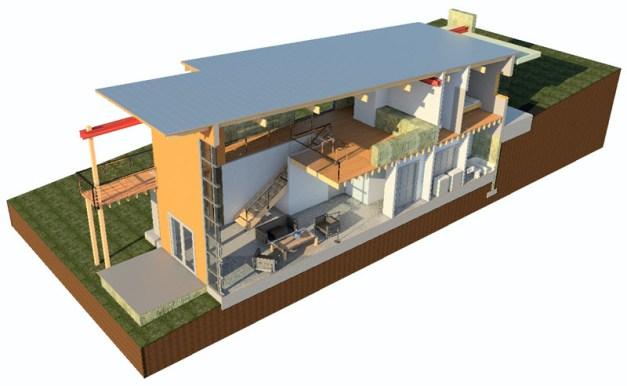
So now you’ve got a terrific building and you’ve got your site’s terrain modeled, and – consequently – you’ve got a grassy slope running through your building lobby. This just won’t do! That’s where the Revit building pad comes into play. Even though you and I know the dirt should be retained at the exterior of a building’s wall, Revit doesn’t catch on to that. You need to tell Revit where the boundary of your building is, so that it knows to cut a void out of the terrain.
The terrain is called a “Toposurface” in Revit, and an Autodesk Revit “Building Pad” will automatically cut through a toposurface. Usually this cutting boundary follows an outline of your building’s basement walls or follows along a retaining wall.
I’ve broken the exploration of this process into two parts so you can take note of two different workflow situations.
The Part 1 video is the process when the building walls and the toposurface are in the same file. (one .RVT file).
The Part 2 video is the process to follow when the building walls and the toposurface are in separate files that are linked together. (two .RVT files that reference each other).
Let’s explore this together…
Part 1:
Part 2:
I hope that these tips help. Let us know if there are any features or questions you have. You can contact us by phone (800.836.5440) or email (Synergiscad@synergis.com).
-Curt
Check out these other posts by Curt:
- Video Post: Displacement with Revit
- Video Post: Editing Wall Types
- Video Post: The Business Value of BIM
- Video Post: BIM in the Cloud
Curt joined Synergis in 2011 as a Solutions Engineer for the AEC Building side with over 20 years of industry experience and both bachelor’s and master’s degrees in Architecture as well as a BFA in Interior Design and Planning. He has software expertise in nearly all the Autodesk architectural software having spent much of his career with Autodesk as a Technical Account Manager, and prior to this working in the AEC and Utilities industries.
Synergis in 2011 as a Solutions Engineer for the AEC Building side with over 20 years of industry experience and both bachelor’s and master’s degrees in Architecture as well as a BFA in Interior Design and Planning. He has software expertise in nearly all the Autodesk architectural software having spent much of his career with Autodesk as a Technical Account Manager, and prior to this working in the AEC and Utilities industries.
Contact us, visit the Synergis website or subscribe to our blog.
By Curt Egli, Synergis Building Solutions Engineer. This blog was originally published on the Synergis blog and is re-printed here with kind permission.

















































